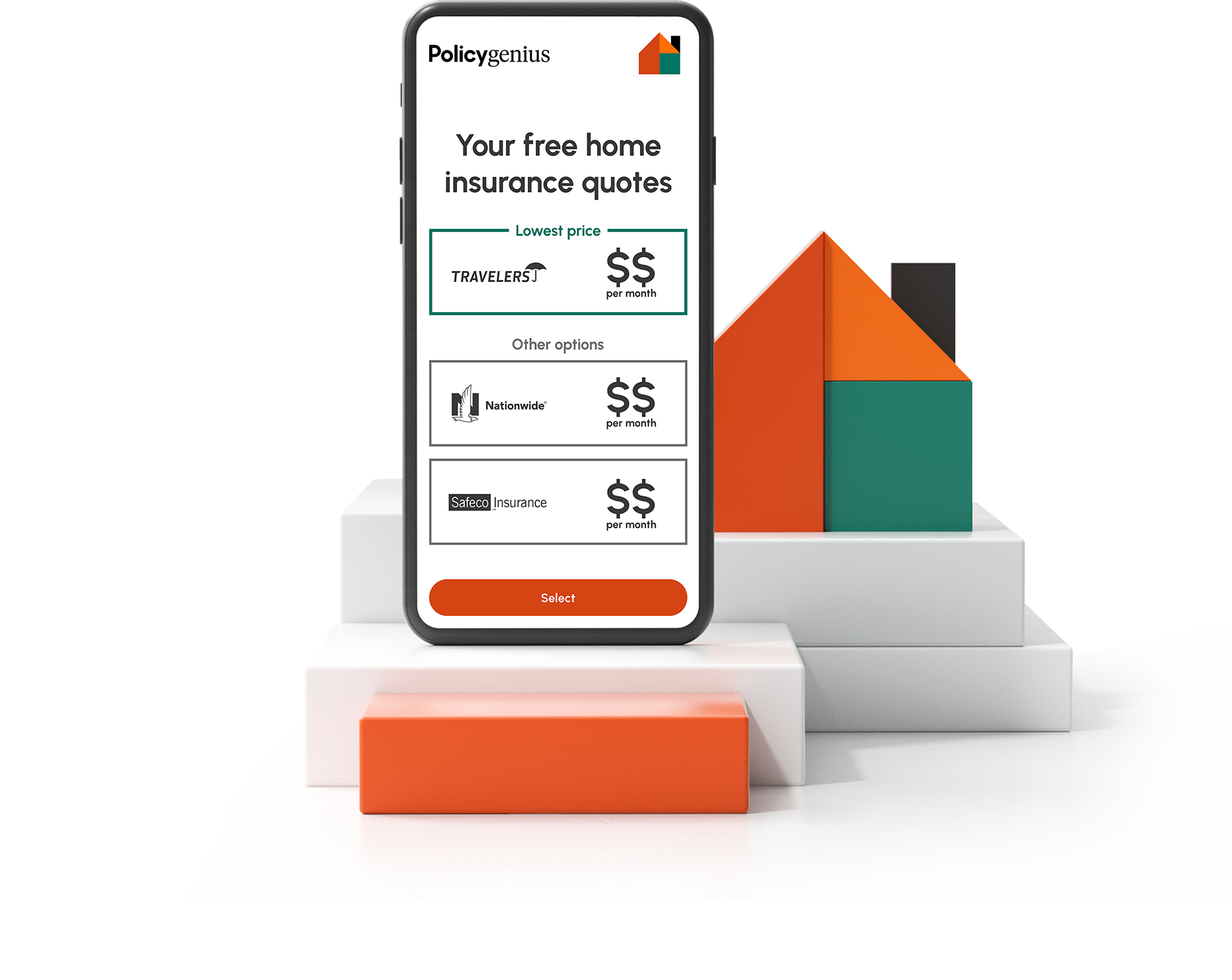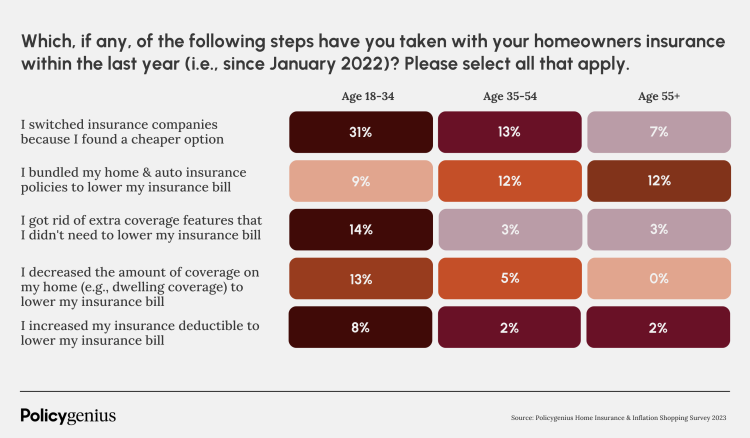How much is homeowners insurance in the U.S.?
The average cost of homeowners insurance in the U.S. is $1,754 per year, or $146 a month, according to a 2023 Policygenius analysis of home insurance premiums in every U.S. state and ZIP code.
Keep in mind that this is just an estimate. Your actual homeowners insurance rates will depend on several factors, such as your state, city, or ZIP code; how much dwelling coverage you need to completely rebuild your home after a disaster; your home's size, age, and other characteristics; and personal factors like your credit score and claims history.
For this analysis, our licensed insurance experts at Policygenius looked at sample quotes for a 40-year-old homeowner with $300,000 in dwelling coverage, $300,000 in liability coverage, and a $1,000 deductible.
How much does homeowners insurance cost in your state?
Your homeowners insurance rate can vary by hundreds or even thousands of dollars depending on the state you live in and whether your home is susceptible to severe storms or natural disasters. Depending on where you live, you can expect to pay anywhere from around $300 a year to over $4,000 a year — a $3,700 difference. To see the typical cost of home insurance where you live, hover over your state on the map below.
Average home insurance costs have increased significantly in each state in 2024, but homeowners in states with a relatively low risk of natural disasters — such as Vermont and New Hampshire — likely haven't seen the same level of sticker shock as more high-risk coastal states.
Here is the average cost of home insurance per month and annually in each state, along with the percentage difference from the average homeowners insurance cost in the U.S. of $1,754 per year.
State | Average annual cost | Average monthly cost | Difference from national average (%) |
|---|---|---|---|
$1,355 | $113 | -23% | |
$1,940 | $162 | 11% | |
$2,838 | $237 | 62% | |
$1,667 | $139 | -5% | |
$1,383 | $115 | -21% | |
$2,322 | $194 | 32% | |
$1,329 | $111 | -24% | |
$918 | $77 | -48% | |
$2,288 | $191 | 30% | |
$1,950 | $163 | 11% | |
$486 | $41 | -72% | |
$1,686 | $141 | -4% | |
$1,258 | $105 | -28% | |
$1,720 | $143 | -2% | |
$1,668 | $139 | -5% | |
$2,981 | $248 | 70% | |
$2,565 | $214 | 46% | |
$2,452 | $204 | 40% | |
$1,275 | $106 | -27% | |
$1,539 | $128 | -12% | |
$1,020 | $85 | -42% | |
$1,422 | $119 | -19% | |
$1,829 | $152 | 4% | |
$2,579 | $215 | 47% | |
$2,624 | $219 | 50% | |
$2,140 | $178 | 22% | |
$1,545 | $129 | -12% | |
$1,884 | $157 | 7% | |
$3,510 | $293 | 100% | |
$953 | $79 | -46% | |
$886 | $74 | -49% | |
$1,681 | $140 | -4% | |
$1,191 | $99 | -32% | |
$1,114 | $93 | -36% | |
$1,236 | $103 | -30% | |
$4,161 | $347 | 137% | |
$869 | $72 | -50% | |
$1,101 | $92 | -37% | |
$1,303 | $109 | -26% | |
$1,653 | $138 | -6% | |
$311 | $26 | -82% | |
$2,095 | $175 | 19% | |
$2,919 | $243 | 66% | |
$894 | $75 | -49% | |
$1,277 | $106 | -27% | |
$865 | $72 | -51% | |
$1,159 | $97 | -34% | |
$1,150 | $96 | -34% | |
$1,426 | $119 | -19% | |
$1,547 | $129 | -12% |
Based on a policy with $300,000 in dwelling coverage
Learn more >> How to calculate homeowners insurance costs
What are the cheapest & most expensive states for home insurance?
The states with the cheapest average cost of homeowners insurance in 2024 are South Dakota, Hawaii, Vermont, Oregon, and New Jersey. All of these states have average home insurance premiums of under $1,000 a year for a home with $300,000 in dwelling coverage.
The most affordable states for homeowners insurance
1. South Dakota: $311 per year
2. Hawaii: $486 per year
3. Vermont: $865 per year
4. Oregon: $869 per year
5. New Jersey: $886 per year
On the flip side, the states with the most expensive average home insurance costs in 2024 are Oklahoma, Nebraska, Kansas, Texas, and Arkansas. One thing most of these states have in common? They're all located in or around Tornado Alley — a region of the country that sees frequent twisters and hailstorms throughout the year.
The most expensive states for homeowners insurance
1. Oklahoma: $4,161 per year
2. Nebraska: $3,510 per year
3. Kansas: $2,981 per year
4. Texas: $2,919 per year
5. Arkansas: $2,838 per year
Learn more >> Cheap homeowners insurance companies for 2024
How much does home insurance cost in your city?
To find the average homeowners insurance cost by city, we analyzed premiums from over a dozen carriers in 67 of the largest metropolitan areas in the U.S. To ensure we were providing homeowners with meaningful insights, we calculated each city's average annual and monthly rate, and broke down how these costs compare to the overall average in the state where the city is based.
Miami had the most expensive rate at $3,572 per year, while Portland's average rate of $801 per year was the cheapest of the cities we analyzed.
City | Average annual cost | Average monthly cost | Difference from state average (%) |
|---|---|---|---|
$1,025 | $85 | -8% | |
$1,488 | $124 | -11% | |
$2,049 | $171 | 5% | |
$2,158 | $180 | -26% | |
$1,826 | $152 | 19% | |
$1,467 | $122 | 15% | |
$1,605 | $134 | 4% | |
$2,130 | $178 | 24% | |
$1,240 | $103 | 0% | |
$1,239 | $103 | 0% | |
$2,984 | $249 | 29% | |
$1,266 | $106 | 2% | |
$2,466 | $206 | -16% | |
$3,284 | $274 | 13% | |
O | $3,021 | $252 | 30% |
$2,327 | $194 | 64% | |
$1,749 | $146 | 13% | |
$1,909 | $159 | -17% | |
$3,258 | $272 | 12% | |
$1,479 | $123 | 11% | |
$1,183 | $99 | -1% | |
$2,936 | $245 | 1% | |
$1,831 | $153 | 10% | |
$1,884 | $157 | -18% | |
$1,029 | $86 | 16% | |
$2,567 | $214 | -14% | |
$2,864 | $239 | 23% | |
$1,249 | $104 | 5% | |
$1,566 | $131 | 13% | |
$2,086 | $174 | -19% | |
$2,197 | $183 | 5% | |
$3,572 | $298 | 56% | |
$1,235 | $103 | 7% | |
$2,010 | $168 | 10% | |
$2,502 | $209 | 9% | |
$2,023 | $169 | -3% | |
$1,032 | $86 | 16% | |
$2,805 | $234 | 14% | |
NY | $1,511 | $126 | 36% |
$1,945 | $162 | -15% | |
$3,375 | $281 | 16% | |
$2,405 | $200 | -19% | |
$2,315 | $193 | 1% | |
$1,654 | $138 | 50% | |
$1,781 | $148 | 7% | |
$1,138 | $95 | 3% | |
$801 | $67 | -8% | |
$1,760 | $147 | 14% | |
$1,257 | $105 | -2% | |
$1,237 | $103 | -11% | |
$899 | $75 | 1% | |
$2,365 | $197 | -19% | |
$1,333 | $111 | -4% | |
$1,244 | $104 | -10% | |
$1,258 | $105 | -9% | |
$1,434 | $120 | -15% | |
$1,887 | $157 | -3% | |
$1,643 | $137 | -1% | |
$1,130 | $94 | -3% | |
$1,176 | $98 | 1% | |
$2,475 | $206 | -4% | |
$2,389 | $199 | -7% | |
$1,888 | $157 | -17% | |
$2,266 | $189 | -1% | |
$1,621 | $135 | -3% | |
$3,735 | $311 | -10% | |
$1,947 | $162 | 52% |
Based on a policy with $300,000 in dwelling coverage
Average homeowners insurance cost by company
Home insurance rates can vary significantly from company to company — even for the same home or coverage amounts. That's because every company has its own way of evaluating risk and determining home insurance premiums.
For example, while Company A may offer the cheapest rates for homeowners with low credit scores or homes that are riskier to insure, Company B may offer better discounts or more competitive rates for less risky properties. To get an idea of what company offers the best coverage at the cheapest rate for your situation, you'll want to compare home insurance quotes from multiple providers.
Looking at the average annual cost of home insurance for the largest home insurance companies in the U.S. by market share, we found that Erie has the least expensive rate at $1,284 per year, while Country Financial's average annual premium of $2,646 is the most expensive.
Company | Average annual cost | Average monthly cost | Difference from national average (%) |
|---|---|---|---|
$1,284 | $107 | -27% | |
$1,339 | $112 | -24% | |
$1,373 | $114 | -22% | |
$1,406 | $117 | -20% | |
$1,479 | $123 | -16% | |
$1,487 | $124 | -15% | |
$1,568 | $131 | -11% | |
$1,633 | $136 | -7% | |
$1,650 | $137 | -6% | |
$1,692 | $141 | -4% | |
$1,706 | $142 | -3% | |
$1,756 | $146 | 0% | |
$1,835 | $153 | 5% | |
$1,845 | $154 | 5% | |
$1,879 | $157 | 7% | |
$1,887 | $157 | 8% | |
$1,966 | $164 | 12% | |
$2,493 | $208 | 42% | |
$2,646 | $220 | 51% |
Based on a policy with $300,000 in dwelling coverage
Learn more >> Best home insurance companies in 2024
Average home insurance cost by dwelling coverage amount
The cost of homeowners insurance is largely based on how much dwelling coverage is in your policy. Dwelling coverage refers to the portion of home insurance that pays to rebuild your house from the ground up should it be completely destroyed by a covered peril, like a tornado or wildfire.
The amount of dwelling coverage in your policy should be equal to your home's replacement cost, which is based on factors like your home's square footage, local construction costs, building materials, and more. If your house is larger or very customized, you'll likely need more dwelling coverage and will pay higher premiums.
Scroll down to find the average cost of homeowners insurance for homes with different amounts of dwelling coverage.
How much is homeowners insurance on a $200,000 house?
Homeowners insurance on a $200,000 house costs an average of $1,298 per year. But this cost can vary widely from $601 to $2,935 per year depending on where you live and other circumstances.
$200,000 dwelling | Yearly cost | Per month cost |
|---|---|---|
Average of low end rates | $601 | $50 |
Average of middle rates | $1,140 | $95 |
Average of high end rates | $2,935 | $245 |
Overall national average | $1,298 | $108 |
Based on a policy with $200,000 in dwelling coverage. Dwelling coverage reflects the cost of rebuilding a home, not its market value
How much is homeowners insurance on a $300,000 house?
Homeowners insurance on a $300,000 house costs an average of $1,754 per year. But this cost can vary widely from $802 to $3,987 per year depending on where you live and other circumstances.
$300,000 dwelling | Yearly cost | Per month cost |
|---|---|---|
Average of low end rates | $802 | $67 |
Average of middle rates | $1,539 | $128 |
Average of high end rates | $3,987 | $332 |
Overall national average | $1,754 | $146 |
Based on a policy with $300,000 in dwelling coverage. Dwelling coverage reflects the cost of rebuilding a home, not its market value
How much is homeowners insurance on a $400,000 house?
Homeowners insurance on a $400,000 house costs an average of $2,222 per year. But this cost can vary widely from $999 to $5,064 per year depending on where you live and other circumstances.
$400,000 dwelling | Yearly cost | Per month cost |
|---|---|---|
Average of low end rates | $999 | $83 |
Average of middle rates | $1,947 | $162 |
Average of high end rates | $5,064 | $422 |
Overall national average | $2,222 | $185 |
Based on a policy with $400,000 in dwelling coverage. Dwelling coverage reflects the cost of rebuilding a home, not its market value
How much is homeowners insurance on a $500,000 house?
Homeowners insurance on a $500,000 house costs an average of $2,724 per year. But this cost can vary widely from $1,198 to $6,238 per year depending on where you live and other circumstances.
$500,000 dwelling | Yearly cost | Per month cost |
|---|---|---|
Average of low end rates | $1,198 | $1,198 |
Average of middle rates | $2,379 | $198 |
Average of high end rates | $6,238 | $520 |
Overall national average | $2,724 | $227 |
Based on a policy with $500,000 in dwelling coverage. Dwelling coverage reflects the cost of rebuilding a home, not its market value
Learn more >> How to estimate home insurance replacement cost
How different factors affect homeowners insurance rates
In addition to where you live and how much coverage you need, most home insurance companies will also consider the age of your home, your claims history, and your deductible level when estimating your premiums.
Here are just a few factors that home insurance companies consider when determining your homeowners insurance rates, along with how much you can expect to pay for each given scenario.
Average homeowners insurance cost by home age
Older homes are often constructed with outdated materials that are more expensive to replace. Additionally, many have obsolete plumbing, electrical, and home systems that increase the probability of accidental fires or water damage.
Given the increased risk of damage and claims, you'll generally have to pay more for home insurance as your home ages. On average, it's roughly $800 cheaper to insure a new home compared to one that's 30 years old.
Age of home | Average annual cost | Average monthly cost |
|---|---|---|
New | $1,107 | $92 |
10 years old | $1,635 | $136 |
20 years old | $1,868 | $156 |
30 years old | $1,925 | $160 |
100 years old | $1,943 | $162 |
Based on a policy with $300,000 in dwelling coverage
Learn more >> Best home insurance for older homes
Average homeowners insurance cost by deductible level
A home insurance deductible is the amount you’re required to pay out of pocket on each claim before your insurance kicks in to cover the remainder of the costs.
Opting for a higher deductible — like $2,000 instead of $500 — will lower your homeowners insurance rates, but it also means you'll have to contribute more of your own money to each claim.
Here’s the average annual home insurance cost by deductible level.
Deductible level | Average annual cost | Average monthly cost |
|---|---|---|
$500 | $1,787 | $149 |
$1,000 | $1,492 | $124 |
$2,000 | $1,446 | $121 |
Based on a policy with $300,000 in dwelling coverage
Learn more >> How to home insurance deductibles work?
Average home insurance cost by claims history
Claims history is another factor insurers take into account when calculating your home insurance rate. If you've filed more than one claim in the past five years, you'll generally pay higher home insurance rates since insurers view you to be at greater risk of filing another one.
Here's the average annual premium for a homeowner with a clean claims history versus a homeowner with one, three, or five claims on their record.
Number of claims | Average annual cost | Average monthly cost |
|---|---|---|
0 claims | $1,925 | $160 |
1 claim | $2,093 | $174 |
3 claims | $2,902 | $242 |
5 claims | $4,339 | $362 |
Based on a policy with $300,000 in dwelling coverage
Learn more >> What factors affect the cost of homeowners insurance?
Why home insurance rates are increasing in 2024
According to the latest 2023 Policygenius Home Insurance Pricing Report, home insurance premiums increased 35% nationally from May 2021 to May 2023, with homeowners in Florida (68%), New Mexico (47%), Colorado (46%), Idaho (46%), and Texas (46%) facing the biggest average increases during that span.
These states and many others with high premium increases the past few years have dealt with a combination of more expensive natural disaster losses, high inflation, and turbulent market conditions that has caused home insurance to be both less affordable and accessible for homeowners.
And this trend of high home insurance prices has continued on in 2024. Here's a deeper look at the biggest factors causing higher home insurance rates this year:
Above-average inflation that increases home rebuild costs
Inflation throughout the country still remains higher than historical averages. [1] Add to this above-average construction costs nationwide and labor shortages, and the cost to rebuild your home is likely to remain more expensive than normal.
Increasingly severe weather and climate change
Insurance companies have experienced record losses in recent years — particularly in places like Florida, Texas, California, and Colorado — due to increasingly severe weather and natural disasters. To both recoup prior years' losses and to account for anticipated losses that are expected to only worsen with climate change, insurance companies have hikeed insurance rates to pass on the risk to policyholders. [2]
Fewer carriers willing to write policies in high-risk states
When there are fewer insurers left to choose from in a particular state or region, the ones remaining will often implement stricter underwriting criteria and increase costs to reflect both the higher demand and exposure, resulting in higher premiums for homeowners. We've seen this trend continue on in high-risk states like Florida and California.
Just last year, Allstate and State Farm stopped writing new policies in California, Farmers placed a cap on how many new policies it would write in the Golden State, and Safeco dropped around 1,000 policies in the Bay Area.
The same goes for Florida, where as many as 10 companies have already gone insolvent since 2020. [3] Last year, AAA announced it would not renew home insurance policies in "higher-exposure" areas of Florida, and Farmers announced it will stop writing new policies and won't renew thousands of existing ones. [4] This is on top of Progressive, AIG, and Heritage who had already announced they were no longer writing new policies in Florida.
How to lower home insurance costs
Homeowners insurance rates are going up everywhere due to higher rebuild costs, more severe natural disasters, and other things beyond our control.
But there are several actions you can take to reduce your rates and ensure you're not paying more than you should be for homeowners insurance.
Compare home insurance quotes. Experts recommend comparing home insurance rates from multiple companies at least once a year to ensure you aren't missing out on a better deal elsewhere. In fact, Policygenius saves customers an average of $455 per year when they re-shop their homeowners insurance.
Bundle home & auto insurance policies. One of the most foolproof ways to lower insurance costs is to bundle home and auto insurance with the same company. Policygenius saves customers an average of $1,250 per year when they bundle their policies through one of our partner insurance companies.
Install home protective devices or features. When you take steps to make your home safer, such as by installing a home security system or wind mitigation features, you may be able to shave a significant amount off your insurance bill.
Improve your credit score. Making a conscious effort to pay down your credit card debt, make payments on time, and avoid opening up new accounts will help your overall financial health — and give you lower home insurance rates to boot.
Increase your deductible. Opting for a higher deductible can help you pay lower premiums each month. Just make sure you have enough in savings to cover the higher out-of-pocket costs.
Choose accurate coverage amounts. Just 44% of U.S. homeowners reviewed their home insurance policy from January 2022 to January 2023 to see how much coverage they had, according to the Policygenius Home Insurance & Inflation Shopping Survey. This means you may be missing out on an opportunity to get rid of coverage you don't absolutely need to lower your rates.
Think twice before filing a small claim. Since your claims history directly impacts the cost of your home insurance, avoid filing a claim for smaller incidents that wouldn’t cost you too much to just pay yourself out of pocket.
Reconsider liability risks. Trampolines, tree houses, and other “attractive nuisances” are a liability risk and having one on your property can result in higher premiums. If your kid moved off to college and you don't have any use for these structures anymore, consider removing them to lower your home insurance rate.
Learn more >> Home insurance discounts & savings
How real customers lowered their home insurance bill last year
With the increase in insurance rates nationwide over the last year, we ran a survey in February 2023 to see what homeowners did last year to offset these high costs and lower their insurance bill.
According to the Policygenius Home Insurance & Inflation Shopping Survey, 51% of homeowners lowered their home insurance costs last year by switching companies for a cheaper option, followed by 33% who bundled their home and auto insurance policies to get a cheaper rate.
Methodology
Policygenius' home insurance rate analysis is based on sample quotes from Quadrant Information Services from over 120 insurance companies in every state and ZIP code in the United States. Our sample quotes were based on a 40-year-old homeowner with no claims history, good credit, a $1,000 deductible, and the following coverage limits for the home:
Dwelling: $300,000
Other structures: $30,000
Personal property: $150,000
Loss of use: $60,000
Liability: $300,000
Medical: $1,000
When analyzing costs for different coverage levels and risk factors, we changed just one variable at a time to ensure the rates we’re comparing are fair and representative of the factor at hand.
Some carriers may be represented by affiliates or subsidiaries. Rates provided are a sample of costs. Your actual quotes may differ.




